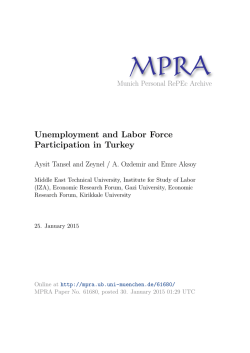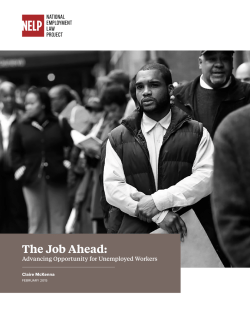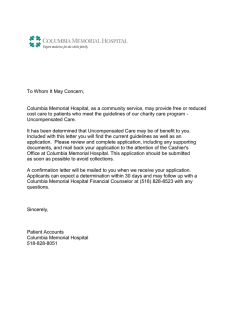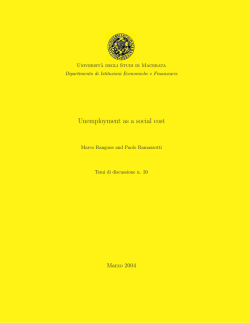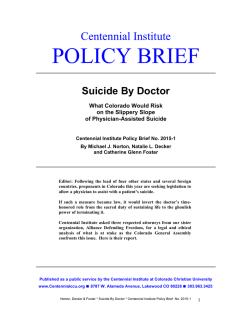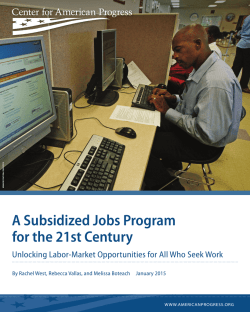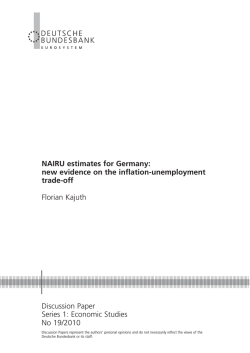
Unemployment and suicidal behaviour
COMMENTARIES 558 which are likely to be linked to rising unemployment rates, are also associated to an increased use of public funded facilities. From 1988 to 1994, for example, the number of patients discharged from US hospitals with a diagnosis of a mental illness increased from 1.4 to 1.9 millions over the whole period.10 In particular, the rate of discharges with a diagnosis of a severe mental illness significantly increased from 196 to 314 per 100 000 of the general population. It seems that the change in mental health care provision that occurred in the USA with the institution of the Medicaid program diverted the most severe patients to the public sector, so that public programmes have increasingly replaced private insurance as the most important source of payment in the USA. Being creative in counteracting the most negative consequences of unemployment could therefore usefully interlace with current active public health programmes, which emphasise costs containment and saving. Any effort will be in vain, however, if the clinicians fail to use the most sensitive instrument they have: the ability to listen to patients and their families’ complaints. Always ask: how is your work going? J Epidemiol Community Health 2003;57:557–558 ..................... Author’s affiliations A Preti, Department of Psychology, University of Cagliari, and Genneruxi Medical Centre, Cagliari, Italy Correspondence to: Dr A Preti, Centro Medico Genneruxi, via Costantinopoli 42, I-09129, Cagliari, Italy; [email protected] REFERENCES 1 De Leo D. Why are we not getting any closer to preventing suicide? Br J Psychiatry 2002;181:372–4. 2 Blakely TA, Collings SCD, Atkinson J. Unemployment and suicide. Evidence for a Suicide ................................................................................... Unemployment and suicidal behaviour D Lester, B Yang ................................................................................... The role of economic policy I n the mid-1980s, Stephen Platt published two reviews of the literature that indicated that unemployment was associated with an increased risk of completed suicide and an increased risk of attempted suicide (sometimes referred to as parasuicide).1 2 As we have pointed out, the association between unemployment and suicidal behaviour seems to be more reliable at the individual level than at the aggregate level.3 For example, in time series studies of 14 nations with available data for the period 1950–1985, Lester and Yang found a positive association between unemployment and completed suicide rates in only 10 nations, and this association was statistically significant in only four nations.4 The article by Tony Blakely and his colleagues in this issue of the journal provides excellent support for the association between unemployment and completed suicide at the individual level.5 The use of national records in a single country for over 2 million 18–64 year olds provides a sample far greater than samples used in previous research, and the inclusion of control variables makes the conclusions of the study more meaningful. www.jech.com For future research, there are several issues that need to be addressed. Firstly, the discrepancy between the results of studies at the individual level and at the aggregate level needs to be addressed. Why do time series studies of unemployment and suicide rates fail to find a consistent association, an inconsistency found also in cross sectional studies over, for example, regions within a county? This discrepancy between the results of what we have called macrosocionomic and microsocionomic research designs6 is common to many phenomena in the social and behavioural sciences and raises difficult problems for sociological theories. Secondly, the role of mental health in the association between unemployment and suicidal behaviour needs to be explored further. Does unemployment increase the risk of serious psychiatric problems that in turn increase the risk of suicidal behaviour or, alternatively, are those with psychiatric problems more likely to become unemployed and also more likely to engage in suicidal behaviour? Ezzy has noted, in his review of the association between unemployment and mental health, that unemployment does causal association? J Epidemiol Community Health 2003;57:594–600. 3 Dooley D, Catalano R, Wilson G. Depression and unemployment: panel findings from the Epidemiological Catchment Area study. Am J Community Psychol 1994;22:745–65. 4 Whitley E, Gunnell D, Dorling D, et al. Ecological study of social fragmentation, poverty, and suicide. BMJ 1999;319:1034–7. 5 Kposowa AJ. Unemployment and suicide: a cohort analysis of social factors predicting suicide in the US National Longitudinal Mortality Study. Psychol Med 2001;31:127–38. 6 Fergusson DM, Horwood LJ, Woodward LJ. Unemployment and psychosocial adjustment in young adults: causation or selection? Soc Sci Med 2001;53:305–20. 7 Zimmerman SL. States’ spending for public welfare and their suicide rates, 1960 to 1995: what is the problem? J Nerv Ment Dis 2002;190:361–3. 8 Proudfoot J, Guest D, Carson J, et al. Effect of cognitive-behavioural training on job-finding among long-term unemployed people. Lancet 1997;350:96–100. 9 Brown GK, Beck AT, Steer RA, et al. Risk factors for suicide in psychiatric outpatients: a 20-year prospective study. J Consult Clin Psychol 2000;68:371–7. 10 Mechanic D, McAlpine DD, Olfson M. Changing patterns of psychiatric inpatient care in the United States, 1988–1994. Arch Gen Psychiatry 1998;55:785–91. not always result in worse mental health.7 Indeed, a minority of people show an increase in psychological wellbeing once they become unemployed. For which people does unemployment have a deleterious impact (including an increased risk of suicidal behaviour) and for which people does it have a beneficial impact? Blakely and his colleagues in their article in this issue, using indirect methods, argue that about half of the increased risk of death from suicide is attributable to the mediating role of the increased level of mental illness. Eventually, the issue of the role of mental illness in the association between unemployment and suicidal behaviour can be resolved only by a study of people who receive adequate psychiatric evaluations while employed and subsequently when unemployed, together with appropriate control groups. The association between unemployment and suicidal behaviour also raises another issue, one concerning public policy decisions. At the present time, before construction projects are approved by governments (local and national), environmental impact statements are demanded and, if the environmental impact is considered to be too harmful, the project may be delayed and even forbidden. Threatening the extinction of a rare species or introducing toxic chemicals into the local environment are the kinds of impacts that can thwart a project. Economic decisions made by local and national governments apparently have an impact on people. In the present instance, unemployment seems to lead to an increased mortality from suicide. It is clear, therefore, that economic policy COMMENTARIES decisions made by governments (or by their designated decision makers such as the Federal Reserve Bank in the USA) can have a tremendous impact on the population. We have suggested that those making such decisions should prepare formal “impact” statements in the same way that developers and construction companies are required to do.8 A focus on solely economic issues may suggest particular actions for public policy makers, while consideration of the psychological and social impact of those actions may change these decisions. Indeed, many European nations have regulations in place preventing companies from laying off employees during hard financial times for the companies, and the Employment Committee of the House of Commons in the United Kingdom has requested memoranda from 559 social scientists concerning the psychological impact of unemployment in order to help them make appropriate decisions.9 This should become more common, and it would provide an important role for social scientists in future public policy decisions. J Epidemiol Community Health 2003;57:558–559 ..................... Authors’ affiliations D Lester, Psychology Program, The Richard Stockton College of New Jersey, Pomona, New Jersey 08240–0195, USA B Yang, Department of Economics and International Business, Bennett S Lebow College of Business, Drexel University, Philadelphia, USA Correspondence to: Dr D Lester; [email protected] Suicide ................................................................................... Research on unemployment and suicide A J Kposowa ................................................................................... Problems and consequences M any capitalist economies are characterised by business cycles with concomitant increases in joblessness during recessions and depressions, and reductions in unemployment in periods of economic expansion. In view of the potentially debilitating consequences of joblessness on health and related outcomes, research on unemployment and suicide continues to be relevant in both epidemiology and sociology. One controversy that continues is the issue of selection bias. The essential question that remains unresolved is whether the observed association between unemployment and suicide reported in some studies reflects direct causation or whether there is some variable that is causally prior to both unemployment and suicide. The report by Blakely et al1 presents an analysis of the New Zealand Census Mortality Study (NZCMS) that attempts to shed some light on the above question. Using logistic regression models on census mortality linked data on 1.65 million men and women aged 18 to 64 years, they have observed that unemployment is strongly associated with suicide among women and men in the age group 25–64. At the same time, no significant associations were observed in other age groups. In an effort to support a causal argument, the authors have controlled for the usual socioeconomic variables (education and income), and to convince readers that there is no confounding (selection bias) Blakely et al1 have also reported results of various sensitivity analyses using information from other studies. The analysis was competently done, but the study is not without serious limitations. Firstly, the key independent variable in the report, employment status is a time varying covariate, but it is not treated as such in the analysis. Failure to account for multiple occurrences even in a given calendar year can distort results by underestimating or overestimating the consequences of joblessness. In short, imprecision and inaccuracies are introduced into the analysis, and despite confidence intervals the validity of conclusions become suspect. Previous studies2 3 suggest that the effect of unemployment on suicide may be more pronounced immediately after job loss. As time progresses the newly unemployed adjust to their novel status and they may be less inclined to commit suicide. Furthermore, with passage of REFERENCES 1 Platt SD. Unemployment and suicidal behavior. Soc Sci Med 1984;19:93–115. 2 Platt SD. Parasuicide and unemployment. Br J Psychiatry 1986;149:401–5. 3 Lester D, Yang B. The economy and suicide. Commack, NY: Nova Science, 1997. 4 Lester D, Yang B. Suicide and homicide in the 20th century. Commack, NY: Nova Science, 1998. 5 Blakely TA, Collings SCD, Atkinson J. Unemployment and suicide. Evidence for a causal assoication? J Epidemiol Community Health 2003;57:594–600. 6 Lester D, Yang B. Microsocionomics versus macrosocionomics as a model for explaining suicide. Psychol Rep 1991;69:735–8. 7 Ezzy D. Unemployment and mental health. Soc Sci Med 1993;37:41–52. 8 Yang B, Lester D. New directions for economics. Journal of Socio-Economics 1995;24:433–46. 9 Lester D, Yang B. Memorandum. The relationship between unemployment and suicide. Submitted on request to the Employment Committee of the House of Commons, London, UK, 18 Jul 1994. time previously unemployed people may find work and thus vacate the “unemployed” status. Secondly, it is unknown in the analysis when job loss occurred. All that is known is that at some point before census night, cohort members became unemployed, but the timing of unemployment is unknown. There is also no information on whether they had experienced more than one episode of unemployment. Blakely et al seem to have linked the mortality information to census data in the three years after census night.1 While this practice may have perhaps reduced the problem regarding the transitional nature of employment status, it did not eliminate it because of the long intercensus period. In the time lag between the current census (the one linked to mortality data) and the prior census, people may have still moved across the three categories of employment status. In view of the above issues, it is imperative that researchers find ways to accommodate peculiarities associated with time varying covariates in cohort and other longitudinal studies. A significant part of the problem in this and most studies of this type is their dependence on official (government collected) datasets. Censuses are not taken primarily for epidemiological research. In many countries enumeration occurs only once in ten or five years (depending on national mandates). As only one enumeration is done there is no provision for follow up data collection on the same people on a weekly or monthly basis. Even if that were possible, the logistics and accompanying financial costs would be prohibitive. One result of this dependence is that very often information is needed by the researcher but it is unavailable in administrative (government) statistics. At www.jech.com
© Copyright 2025
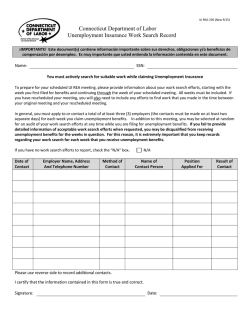

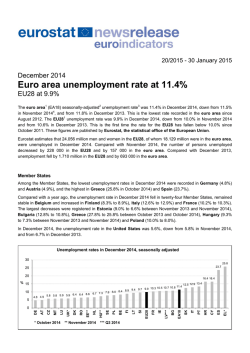
![Download [ PDF ] - journal of evidence based medicine and](http://s2.esdocs.com/store/data/000505409_1-2bc4ae284ea460180bc089744a6eaaca-250x500.png)
